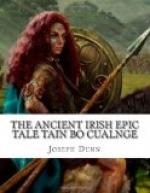By this time King Conchobar and his warriors have come out of their debility and summoned their forces to an eminence in Slane of Meath. The great gathering of the Ulstermen is reported to Medb by her trusty herald macRoth, and from his description of the leaders and their troops, their exiled countryman Fergus designates them to the nobles of Connacht. In the final battle Medb’s army is repulsed and retreats in flight into Connacht. Thus each host has had its share of the fortunes of war: Medb has laid waste the lands of her divorced husband and carried off the Brown Bull of Cualnge, the prize of war, while on the other hand, Conchobar has won the victory in the great battle of Garech and Ilgarech.
VII. The End of the two Bulls
On the way back to Connacht, the Brown Bull of Cualnge emitted such terrible bellowings that they reached the ears of the Whitehorned remaining at home in his stall in Cruachan, whence he rushed at full speed to attack the other. A furious battle took place between the bulls, but the Brown was the stronger, and raising his rival on his horns he shook the Whitehorned into fragments over all Ireland. He then returned in fury to Ulster, and in his wild rage dashed his head against a rock and was killed.
The Tain Bo Cualnge has been preserved, more or less complete, in a score of manuscripts ranging in date from the beginning of the twelfth to the middle of the nineteenth century. There probably existed other manuscripts containing not only the Tain as we have it but even episodes now wanting in it. All of the extant manuscripts go back to versions which date from the seventh century or earlier. No manuscript of the Tain is wholly in the language of the time when it was copied, but, under the cloak of the contemporaneous orthography, contains forms and words so obsolete that they were not understood by the copyist, so that glossaries had to be compiled to explain them.
It is by a singular good fortune that this, the greatest of all the epic tales of the Irish, has been handed down to our day in the two most ancient and, for that reason, most precious of the great Middle Irish collections of miscellaneous contents known as the Leabhar na hUidhre, “the Book of The Dun (Cow),” and the Book of Leinster. The former and older of these vellum manuscripts (abbreviated LU.) is kept in the Library of the Royal Irish Academy at Dublin. It must have been written about the beginning of the twelfth century, for its compiler and writer, Moelmuire macCeilechair (Kelleher), is known to have been slain at Clonmacnois in the year 1106; some of its linguistic forms, however, are as old as the eighth century glosses. Unfortunately, LU.’s account of the Tain is incomplete at the beginning and the end, but the latter portion is made good by the closely related, though independent, version contained in the manuscript known as the Yellow Book of Lecan (abbreviated YBL.). This manuscript was written about the year 1391 and it is also kept in Dublin in the Library of Trinity College. To the same group as LU. and YBL., which for the sake of convenience we may call version A, belong also the British Museum MSS., Egerton 1782, a large fragment, and Egerton 114, both dating from the fifteenth or sixteenth century.




